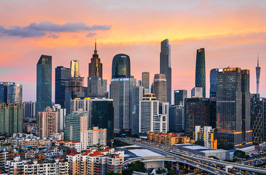Huawei ecosystem starts to take shape
Tech giant will invest $1 billion to encourage software developers to design apps for HarmonyOS
Summer in southern China is known for being extremely hot and sultry. But the oppressive heat with temperatures as high as 38 C failed to prevent about 6,000 software developers and media professionals from all over the world flooding into Dongguan, Guangdong province, last week.
They were there to attend the biggest-ever developer conference held by Chinese technology giant Huawei Technologies Co from Aug 9 to 11. At the event, the world's top telecom equipment maker and the second-largest smartphone vendor unveiled its much-anticipated in-house operating system HarmonyOS.
The move marks Huawei's biggest push to build its own ecosystem centering on a powerful OS, a dream that many Chinese tech heavyweights entertain but none has turned into reality.
 |
|
Huawei releases its inhouse operating system HarmonyOS at a news conference in Dongguan, Guangdong province, on Aug 9. [Photo provided to China Daily] |
Yu Chengdong, CEO of Huawei's consumer business group (CBG), said HarmonyOS is a next-generation operating system designed for the internet of things era. It is designed to deliver a smooth experience across different devices and Huawei plans to use it in smart TVs, automobiles, wearables and other hardware over the next three years.
"You can develop your apps once, then flexibly deploy them across a range of different devices," Yu said.
The ambition is great, but the key to success lies in whether software developers will embrace the new OS and make applications around it. Facing arguably its biggest challenge in its more than 30-year history, Huawei is determined to pour in hefty resources to realize the dream.
The company is driven by a pressing need that if Washington continues to ban the use of Google's Android operating system in its overseas smartphones, Huawei has to bank on HarmonyOS for a replacement.
Ren Zhengfei, founder and CEO of Huawei, said in a speech on July 31 that the company's consumer business group, which chiefly involves smartphones and personal computers, will have to start a long march.
"The CBG was left with two holes. Although (machine-gun fire) didn't hit the heart, it did hit the fuel tank," Ren said. The senior executive frequently describes Huawei as a gun-stricken plane returning to base while urgent work is carried out to fix the holes in its body. It alludes to what the company has gone through since the US government dissuaded its allies from using Huawei in 5G telecom networks and banned the company in May from purchasing any US-originated technologies without special approval.
Ren admitted that it is by no means a one-off push to build an ecosystem. Persistence and consistent input are needed. He hopes the consumer business group can address any issues in two to three years.
Specifically, Huawei will invest $1 billion to encourage software developers to be part of the HarmonyOS ecosystem, with 80 percent of the money going to applications for overseas countries. Foreign consumers are accustomed to Google's Android system, Google Maps and YouTube, but Huawei can't access the updates of these services in its existing smartphones and future models amid the current ban.
Such a worry has already reduced Huawei's smartphone shipments in Europe by 16 percent year-on-year in the second quarter of 2019, a report from market research company Canalys showed.
To solve the challenges, Huawei said it will focus on two aspects - to encourage Chinese app developers to go global and to attract as many overseas app developers as possible.
 |
|
Yu Chengdong, CEO of Huawei's consumer business group, introduces the new HarmonyOS operating system at the news conference in Dongguan on Aug 9. [Photo/Xinhua] |
Zhang Pingan, president of cloud services at Huawei's consumer business group, said the company has years of experience in more than 170 countries and regions, and it will share such experience, including knowledge about local laws, rules and cultural traditions as well as marketing know-how, with domestic app developers.
Huawei also plans to unveil its own mapping service in October in case of a long-term inability to access Google Maps. Known as Huawei Map Kit, it is not directly for consumer use, but is designed to encourage software developers to come up with applications based on its mapping capabilities.
Russian internet heavyweight and mapping service provider Yandex and US travel aggregator website Booking Holdings are among the software companies that are partnering with Huawei on the mapping service.
Thijs Hodde, director of distribution partnerships at Booking, said the company has been cooperating with Huawei for five years and looks forward to expanding such cooperation.
Zhang from Huawei said the company will also significantly reduce its cut from transactions on the platform and let application developers enjoy more profits than Apple and Google do on their Android and iOS app stores.
Huawei is not the first Chinese company to try to develop an operating system. Internet giant Alibaba Group made a similar push, but it failed.
"Compared with internet companies, Huawei's giant hardware base provides its biggest edge in promoting HarmonyOS. The company ships about 300 to 400 million units of hardware every year, including smartphones, personal computers and smartwatches," said Xiang Ligang, director-general of the telecom industry association Information Consumption Alliance.
Just one day after the unveiling of HarmonyOS, Huawei launched the first product that is powered by the system - a smart TV called Honor Vision. Because of the ability of HarmonyOS to reduce the response latency of apps by 25.7 percent, Honor Vision can become a center for multi-device interaction and supports the playing of high-definition mobile games on smart TVs with low latency.
But currently, only four video content apps are available on Honor Vision, including Tencent Video and MGTV. The lack of major videostreaming apps including Youku and iQiyi highlights the difficulty in attracting software developers.
 |
|
Visitors learn about Huawei’s smart watches at an international electronic products exhibition in Shanghai. [Photo provided to China Daily] |
Still, analysts said Huawei made the right move by building Harmony into an open-source operating system and allowing it to be compatible with Android from the start.
"This will prevent it from repeating the fate of Microsoft in promoting smartphone systems," said Jia Mo, an analyst at market research company Canalys.
Microsoft failed to popularize the use of its Windows system in smartphones years ago.
Huawei plans to partner with other companies to set up China's first open-source software foundation, which is expected to start operating in a month or two to expand the nation's software community.
Shao Yang, chief strategy officer of Huawei's consumer business group, said the company knows that it is impossible for Huawei to build the ecosystem alone and a wide range of partners are needed to ensure its vigor.
"Huawei will function as a platform. We will refrain from entering too many sectors. For instance, we won't make artificial intelligence-enabled table lamps or cars. We just want to enable cars to be connected to smartphones," Shao said.
Ma Miao, a software developer, said he is willing to develop mobile applications for the Harmony operating system, but time is needed to see whether Huawei's tools are as easy and efficient as promised.
On the night of Aug 10, Ma went to a concert Huawei held for developers. Loud music and songs resonated around the company's Songshanhu research and development base.
It felt like just a bar and the hustle and bustle, and happy atmosphere made it hard to believe that Huawei has faced US government restrictions for three months.
"I am impressed with Huawei's resilience amid mounting pressure. And I am happy to be part of its long march to popularize HarmonyOS," Ma added.



 Print
Print Mail
Mail

